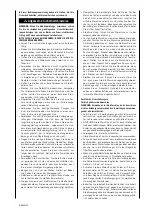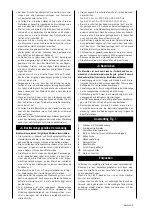
english 17
4 Once the sanding belt is positioned firmly in the clip,
stand in front of the machine and wind it radially round
the cylinder. Turn the cylinder, with your right hand,
away from your body and draw the material around the
cylinder. Use this technique to wrap the sanding belt
radially from edge to edge of the cylinder. Make sure
when wrapping it round, that the sanding material does
not overlap (Fig. 12). It should be smooth with a small
gap but should not overlap while it is being wound
around the head.
5 Once the cylinder is completely wrapped, maintain ten-
sion on the belt and lead the rest of the conical end
into the cylinder slit. Using your right hand, lift up the
tension clip (A) to open the chucks. Push the conical
end of the sanding belt in. The tension clip insures that
the sanding paper and tension are maintained when the
machine is in operation, in case the belt is stretched. If
the belt is not firmly positioned, then the tension clip
was not raised up sufficiently to open the chucks before
the belt was put in (Fig. 13).
Note: In the case where the sanding belt is stretched, it
may be necessary to adjust the clip ends on the sanding
belt again. Make sure that tension is always maintained
during long operation.
Choice of Sanding Grain
The Sanding Process
Sanding (smoothing) of wood is a process that makes
continuously finer scratches in the surface, until these
scratches are so small that they are not visible to the hu-
man eye.
The grain of the sandpaper describes the coarseness of
the sanding materials. The lower the grain number is, that
much coarser is the sand paper and that much larger the
scratches that are made on the surface. Grain 36, there-
fore, makes larger scratches then Grain 60, and Grain 60
is coarser than Grain 80. Coarser grain (such as, for exam-
ples, 36 and 60) can be used to remove materials aggres-
sively and make coarse scratches on the surface, while
with a grain of 220, very little material is removed and the
surface becomes smoother.
Choice of Grain
Normally, the work begins with a coarse grain and moves
on to ever finer grains, until the desired surface quality
or material strength is attained. The choice of the initial
grain depends on an evaluation of the work piece to be
sanded (coarse, smooth, etc.), the width, the hardness or
softness of the wood and the desired results. Below the
general norms are given. (Pre-cut belts in each of the
grains mentioned below can be found at your dealer and
the customer service centre of our factory.)
Grain
Use and Sanding Characteristics
36 Very aggressive: maximum removal, removal of glue,
sanding/planing, removes „cups“ and colour.
60 Middle aggressive: removes material, treats surface
qualities, and removes glue, for sanding end grain.
80 Middle aggressive: removes material, treats surface
qualities, and removes glue, for sanding end grain,
removal of planing marks.
100 Middle to light surface sanding, end grain sanding,
removal of planing marks.
120 Middle to fine: light surface sanding and removal of
materials, for thin wood.
150 Fine: minimal removal, final sanding of a surface,
thin wood.
180 Fine: final sanding.
220 Very fine: final sanding.
m
Electrical connections
Regularly check the electrical connection lines for damag-
es. Please make sure that the connection lines are discon-
nected from the mains supply during the check. Electrical
connection lines must meet the applicable VDE and DIN
regulations and the provisions of the local power supply
company. Only use connection lines labeled with H 07 RN.
The labeling of the connection cable with the type specifi-
cation is required.
• The product meets the requirements of
EN 61000-3-11 and is subject to special connection
conditions. This means that use of the product at
any freely selectable connection point is not allowed.
• Given unfavorable conditions in the power supply the
product can cause the voltage to fluctuate temporarily.
• The product is exclusively intended for use at con-
nection points that have a continuous current-carry-
ing capacity of at least 100 Amper phase.
• As the user, you are required to ensure, in consulta-
tion with your electric power company if necessary,
that the connection point at which you wish to ope-
rate the product meets the specified requirements.
Damaged electrical connections
Often, insulation damages occur on electrical connection
lines.
The possible causes are:
• Drag marks if connection lines are led through window
or door clearances. .
• Kinks due to improper attachment or routing of the
connection line.
• Cuts caused by running over the connection line.
• Insulation damages caused by pulling the connection
line out of the wall socket.
• Fissures caused by the aging of the insulation. Such
defective electrical connection lines must not be used
and are, due to the insulation damages, life threaten-
ing!
Single phase motor 230 V/50 Hz
• The supply voltage must be 220÷240 V/50 Hz.
• The mains connection and extension cable must have
3 wires = P+N+SL. - (1/N/PE).
• Extension lines up to a length of 25 m must have a
minimum cross section of 1.5 mm², lines with a length
exceeding 25 m must have a minimum cross section of
2.5 mm².
• The mains connection is protected with a maximum of
16 A.
m
Maintaining the machine
Warning: In order to prevent any serious injuries, always dis-
connect the machine from the power supply before carrying
out maintenance works or replacing the grinding strips.
















































